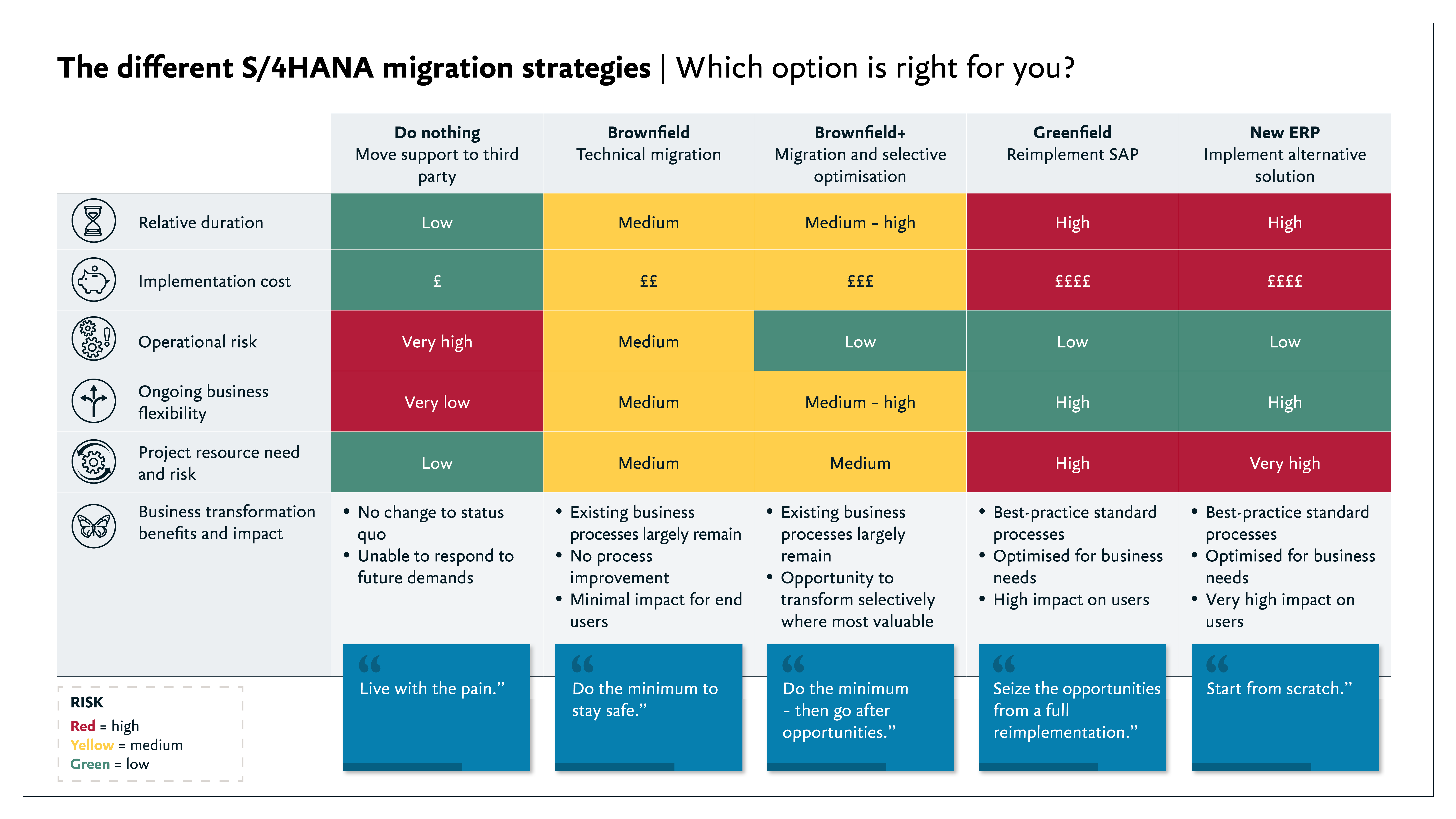SAP has publicly committed to ending support for its ECC6 enterprise resource planning (ERP) system in 2027. Many organisations are wrestling with whether to migrate to its successor, S/4HANA, and if so, how to shape and deliver the project.
Migration offers the opportunity to realise significant benefits, but S/4HANA transformations are large, complex programmes and many organisations don’t know where to begin. We explore the different S/4HANA migration strategies available and discuss the key factors that will determine which is right for your organisation.
The options available for S/4HANA migration
In broad terms, there are five different options available to organisations which are considering an SAP S/4HANA migration. Each has different risks and benefits.

SAP will offer ongoing maintenance for ECC6 beyond 2027 – albeit at a higher cost – if a migration to S4/HANA is underway.
Let’s look at the different S/4HANA migration strategies in detail.
1. Defer S/4HANA migration and seek third-party support
SAP will discontinue support for ECC6 in 2027 so in theory, organisations can defer decision-making for a little longer. It is also possible to extend support beyond 2027 through third-party suppliers such as Spinnaker or Rimini Street.
The advantages of this approach would include minimal project cost, resources, risk and time commitments, and there’d be no change to the business status quo.
But while a “do nothing” approach to ERP upgrades might be tempting, organisations will need to assess the level of operational risk this presents. Technology and processes would largely stay as-is, leaving organisations unable to respond to new business priorities or regulatory changes. The challenge of dealing with legacy technology would remain, and will require a solution at some point in the future.
2. Brownfield: a technical S/4HANA migration strategy
With this option, commonly known as ‘brownfield’ implementation, the organisation would focus on migrating to the latest technology standard, without considering any process transformation, and adopting the minimal level of change required to accommodate the new S/4HANA functionality and data model. Existing processes are re-implemented in S/4HANA and data is moved across. The impact on the business would be minimal, with limited downtime.
While any existing pain points would remain, the ECC6 support issue is resolved and leaves open the possibility of future changes.
Organisations should bear in mind that this option will not be available to all, and is dependent on specific circumstances. For example, some parts of an organisation’s ECC estate may not have an obvious equivalent in S/4HANA, which would mean the right migration strategy would require some degree of re-implementation work.
3. S/4HANA migration with selective optimisation i.e. brownfield+
This migration strategy pursues the same technical benefits as a brownfield implementation, but includes additional innovation goals. Existing business processes remain largely intact, with the opportunity for selective transformation at additional cost. S/4HANA go-live would be followed by incremental improvement projects, building on the new technology platform. These would be determined by business requirements and the opportunities available.
4. Greenfield: migrating to S/4HANA with a full re-implementation
A ‘greenfield’ migration strategy is broadly a wholly new implementation of S/4HANA, typically using an SAP-advocated fit-to-standard approach and minimising customisation as much as possible. Existing processes are redesigned to fit best practice, which maximises the opportunity for transformation and wider business benefits.
As always, greater ambition carries greater risk. Greenfield implementations require the business to have a high degree of ambition and buy-in. They also typically take longer to complete than brownfield, and carry a corresponding increase in required resources and cost.
But don’t be too quick to balk at the sticker price. Organisations need to bear in mind the costs of any follow-on process optimisation after a brownfield implementation. When added together, these can often result in a higher total implementation cost compared to greenfield.
5. Migrate to a new and different ERP
While not actually an S/4HANA migration strategy at all, this option is often overlooked but may be worth considering.
In this scenario, instead of upgrading with SAP, an organisation would implement an alternative ERP system, such as Oracle or Microsoft Dynamics, or a best-of-breed combination of applications, including choices such as Workday, Peoplesoft or Salesforce.
It essentially allows the organisation to start from scratch, which represents potential for huge business transformation benefits and a very high impact for end users. The organisation would be able to shift to best-practice, standard processes and optimise for their business needs.
This option could be a particularly attractive strategy for organisations which are dissatisfied with SAP as a provider or do not have confidence in SAP’s roadmap for their particular technology estate, for example. Other organisations may find that an alternative technology platform better meets the needs of their business.
However, organisations still need to weigh up the risks, costs, duration, and project resources required. Be mindful that there could be hidden costs too. For example, if an organisation has an in-house SAP team, it will need to invest in re-skilling.
Current state and future ambitions determine the right S/4HANA migration strategy
S/4HANA transformations are highly specific to each individual organisation and its ambitions, people, and existing technical landscape. There is no single journey that works for all. To determine the right migration strategy, organisations need to consider which will suit their unique circumstances and enable the specific outcomes they want to achieve.
To assess your organisation’s current state and the appetite for an S/4HANA migration, there are a few key questions you need to answer.
Key questions
to determine the current state and appetite for S/4HANA migration
Question 1
Do you have big ambitions for transformation?
Question 2
Do current business processes align with best practice or are they inefficient?
Question 3
Does your organisation have the political and financial capital to invest in a big transformation programme?
Question 4
Can you find a window in your organisation’s 'change calendar' to accommodate the ERP transition alongside other organisational priorities?
Question 5
Is your organisation able to prepare for and absorb change?
Question 6
Do you have the right people, capability, and capacity, and can you dedicate them to a transformation programme?
If you answer ‘yes’ to more than three of these questions, it’s worth considering a greenfield approach. If not, brownfield may provide entry to S/4HANA at lower cost and risk, leaving open the option to consider further innovation in the future.
Whichever way you may be leaning, a comprehensive current state assessment will help you get to grips with the specifics of your organisation, ensuring you can adopt the S/4HANA migration strategy that best fits your constraints, needs and ambitions.









